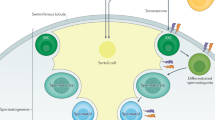Abstract
Late side-effects of stem cell transplantation include hypogonadism with infertility and sexual dysfunction, but gynaecomastia is less well recognised. We report five cases of gynaecomastia with features of hypergonadotrophic hypogonadism (primary testicular failure), who received either a TBI/cyclophosphamide conditioned allograft (n = 3) or a BEAM autograft (n = 2). Patients receiving an allograft had gynaecomastia, Leydig cell insufficiency (LCI) diminished libido and erectile dysfunction. Surgery was required in one case, while in two cases the gynaecomastia resolved spontaneously after 6 months. Two patients also had gynaecomastia and sexual dysfunction, severe hypogonadism, very low testosterone levels and marked hyperprolactinaemia following autoBMT. Both responded well to testosterone replacement therapy (TRT). As a group, all patients had primary testicular failure and all except one, had LCI (compensated or frank). However, there was no correlation between the severity of gynaecomastia and the degree of endocrine dysfunction. This preliminary study is the first to suggest that gynaecomastia, due to primary hypogonadism and LCI, may be a significant complication of myeloablative conditioning therapy. Therefore gynaecomastia in BMT recipients must always be treated as a pathological entity as it may be the external manifestation of a complex endocrine pathology. It is a potentially treatable condition. Although spontaneously reversible, some patients may require TRT or even surgery. We recommend comprehensive endocrine testing in conjunction with a reproductive endocrinologist and prompt intervention to alleviate embarrassment and anxiety in afflicted BMT recipients.
Bone Marrow Transplantation (2001) 28, 1141–1144.
This is a preview of subscription content, access via your institution
Access options
Subscribe to this journal
Receive 12 print issues and online access
$259.00 per year
only $21.58 per issue
Buy this article
- Purchase on Springer Link
- Instant access to full article PDF
Prices may be subject to local taxes which are calculated during checkout
Similar content being viewed by others
References
Howell SJ, Shalet SM . Gonadal damage from chemotherapy and radiotherapy Endocrinol Metab Clin North Am 1998 27: 927–943
Chatterjee R, Goldstone AH . Gonadal damage and effects on fertility after bone marrow transplantation Bone Marrow Transplant 1996 17: 5–11
Mills W, Chatterjee R, McGarrigle HHG et al. Partial hypopituitarism following TBI in adult patients with haematological malignancy Bone Marrow Transplant 1994 14: 471–473
Littley MD, Shalet SM, Beardwell CG et al. Hypopituitarism following external radiotherapy for pituitary tumours in adults Q J Med 1989 262: 145–160
Chatterjee R, Kottaridis PD, McGarrigle HH, Goldstone AH . Patterns of Leydig cell insufficiency in adult males, following bone marrow transplantation for haematological malignancies Bone Marrow Transplant 2001 28: 497–502
Anderson A, Groom JB . Male breast at autopsy Acta Pathol Microbiol Immunol Scand 1982 90: 191–210
Nuttal FQ . Gynaecomastia as a physical finding in normal men J Clin Endocrinol Metab 1979 48: 338–348
Chatterjee R, Kottaridis PD, Lees WR et al. Cavernosal arterial insufficiency and erectile dysfunction in recipients of high dose chemotherapy and total body irradiation for multiple myeloma Lancet 2000 355: 1335–1336
Simon BE, Hoffman S, Kahn S . Classification and surgical correction of gynaecomastia Plast Reconstr Surg 1973 51: 48–52
Faiman C, Winters JSD . Diurnal cycles in plasma FSH, testosterone and cortisol in men J Clin Endocrinol Metab 1971 33: 186–192
Miyatake A, Morimoto Y, Oishi T et al. Circadian rhythm of serum testosterone, and its relation to sleep: comparison with the variation in serum luteinising hormone, prolactin, and cortisol in normal men J Clin Endocrin Metab 1980 54: 1365–1371
Urban MD, Lee PA, Korasky AA et al. Comparison of estimates of gonadotrophin levels by isolated blood samples, integrated blood concentrations and timed urinary fractions J Clin Endocrinol Metab 1979 48: 732–735
Chatterjee R, Mills W, Katz M et al. Germ cell failure and Leydig cell insufficiency in post-pubertal males after autolagous bone marrow transplantation with BEAM for lymphoma Bone Marrow Transplant 1994 13: 519–522
Glass AR . Gynaecomastia Endocrinol Metab Clin North Am 1994 23: 825–837
Vanderpump MPJ, Tunbridge WMG . The effects of drugs on endocrine system (review) Clin Endocrinol 1993 39: 389–397
Aki FT, Tekin ML, Ozen H . Gynaecomastia as a complication of chemotherapy for testicular germ cell tumours Urology 1996 48: 944–946
Chan WB, Yeung VT, Chow CC et al. Gynaecomastia as a presenting feature of thyrotoxicosis Postgrad Med J 1999 75: 229–231
Galbraith RA, Michnovich JJ . The effect of cimertidine on the oxidative metabolism of oestradiol New Engl J Med 1989 321: 269–274
Knigge U, Dejgaard A, Wollesen F et al. The acute and long term effect of the H2-receptor antagonists cimetidine and ranitidine on the pituitary gonadal axis in men Clin Endocrinol 1983 18: 307–313
Reiter WJ, Pycha A, Schatzl G et al. Dehydroepiandrosterone in the treatment of erectile dysfunction: a prospective, double blind, randomized, placebo-controlled study Urology 1999 53: 590–594
Hafez B . Recent advances in clinical/molecular andrology Arch Andro 1998 40: 187–210
Aversa A, Isidori AM, De Martino MU et al. Androgens and penile erection: evidence for a direct relationship between free testosterone and cavernous vasodilatation in men with erectile dysfunction Clin Endocrinol 2000 53: 517–522
Jannini EA, Screponi E, Carosa E et al. Lack of sexual activity from erectile dysfunction is associated with a reversible reduction in serum testosterone Int J Androl 1999 22: 385–392
Gasperoni C, Slagarello M, Gasperoni P . Technical refinements in the surgical treatment of gynaecomastia Ann Plast Surg 2000 44: 455–458
Javaid M, Sdhibu M . Surgical correction of gynaecomastia: a new approach Br J Plastic Surg 2000 53: 174–175
Author information
Authors and Affiliations
Rights and permissions
About this article
Cite this article
Harris, E., Mahendra, P., McGarrigle, H. et al. Gynaecomastia with hypergonadotrophic hypogonadism and Leydig cell insufficiency in recipients of high-dose chemotherapy or chemo-radiotherapy. Bone Marrow Transplant 28, 1141–1144 (2001). https://doi.org/10.1038/sj.bmt.1703302
Received:
Accepted:
Published:
Issue Date:
DOI: https://doi.org/10.1038/sj.bmt.1703302
Keywords
This article is cited by
-
Male gynecomastia and risk for malignant tumours – a cohort study
BMC Cancer (2002)



